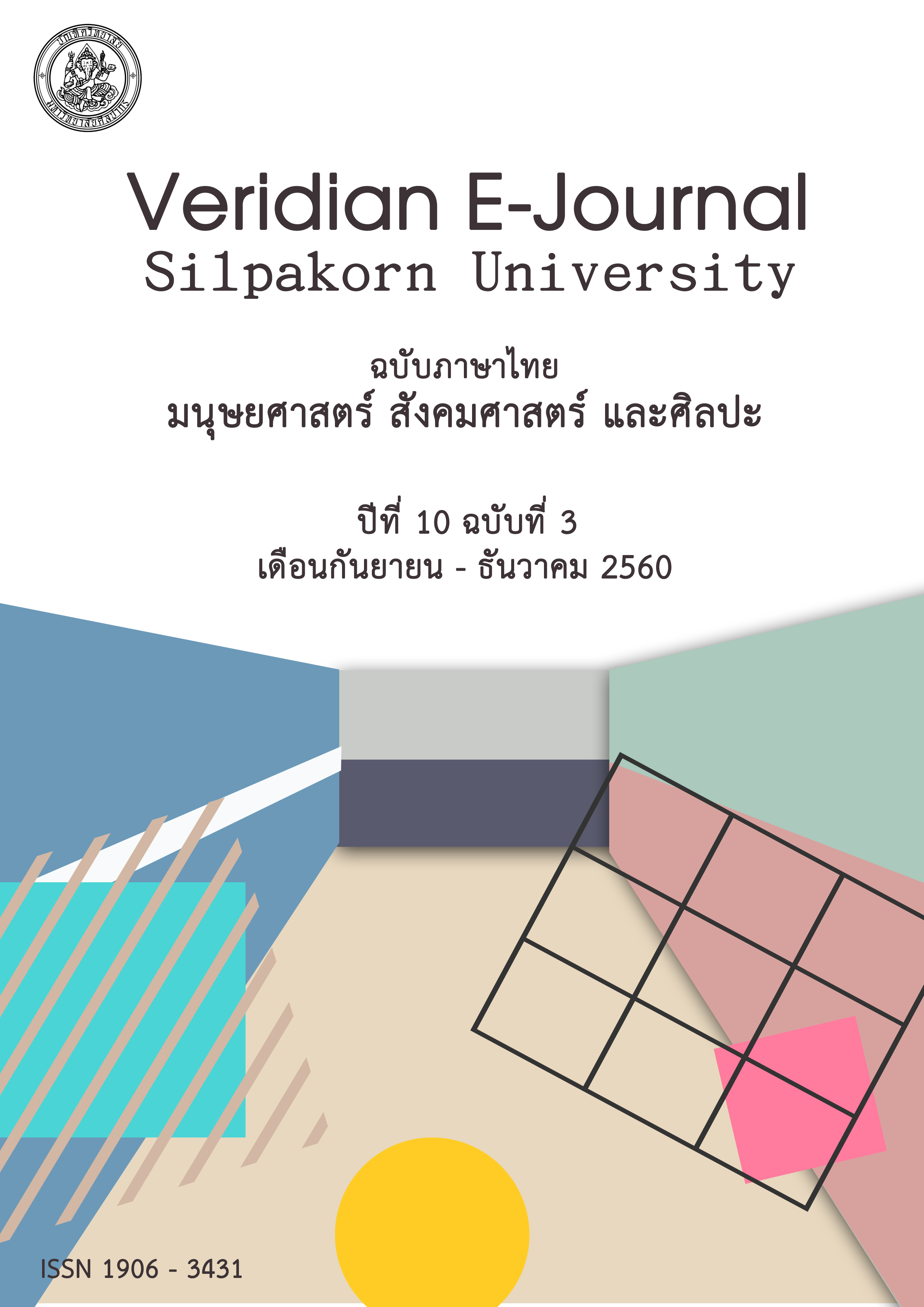การเพิ่มศักยภาพในการจัดการผลิตปาล์มน้ำมันเพื่อการแข่งขัน ในเขตพื้นที่จังหวัดสุราษฎร์ธานี
Main Article Content
Abstract
ปาล์มน้ำมันจัดเป็นพืชที่มีความสำคัญต่อประเทศ ทั้งในแง่เศรษฐกิจ การสร้างความมั่นคงด้านอาหาร และพลังงานของประเทศ โดยมีจังหวัดสุราษฎร์ธานี เป็นจังหวัดที่มีพื้นที่ปลูกปาล์มน้ำมันมากเป็นอันดับหนึ่งของภาคใต้ และของประเทศ
วัตถุประสงค์ของการวิจัย เพื่อศึกษาถึง 1) สถานการณ์การผลิต และสถานการณ์การตลาดปาล์มน้ำมันของเกษตรกร 2) ต้นทุนและผลตอบแทนในการผลิตปาล์มน้ำมันของเกษตรกร 3) ปัจจัยที่คาดว่าจะมีความเกี่ยวข้องกับความเป็นไปได้ในการใช้เทคโนโลยีในการจัดการผลิตปาล์มน้ำมันเพื่อการแข่งขันของเกษตรกร และ4) นโยบาย และมาตรการในการเพิ่มศักยภาพการจัดการผลิตปาล์มน้ำมันเพื่อการแข่งขัน กลุ่มตัวอย่าง คือ ผู้มีส่วนได้ส่วนเสียตลอดโซ่อุปทานในธุรกิจปาล์มน้ำมัน จังหวัดสุราษฎร์ธานี การคัดเลือกกลุ่มตัวอย่างที่เป็นเกษตรกรผู้ปลูกปาล์มน้ำมันในเขตพื้นที่ศึกษา จำนวน 30 ตัวอย่าง ใช้การคัดเลือกกลุ่มตัวอย่างแบบหลายขั้นตอน ส่วนการคัดเลือกผู้มีส่วนได้ส่วนเสียรายอื่น ใช้การคัดเลือกกลุ่มตัวอย่างแบบเฉพาะเจาะจง เครื่องมือที่ใช้ในการเก็บรวบรวมข้อมูล คือ แบบสัมภาษณ์เกษตรกร ส่วนผู้มีส่วนได้ส่วนเสียรายอื่น ใช้แบบสัมภาษณ์เชิงลึก สถิติเชิงพรรณนา คือ ค่าความถี่ ค่าร้อยละ ค่ามัชฌิมเลขคณิต และค่าเบี่ยงเบนมาตรฐาน สถิติเชิงอนุมาน ที่ใช้ในการวิเคราะห์ถึงปัจจัยที่เกี่ยวข้องกับความเป็นไปได้ในการใช้เทคโนโลยีในการจัดการการผลิตปาล์มน้ำมันเพื่อการแข่งขัน คือ สัมประสิทธิ์สหสัมพันธ์แบบเพียร์สัน
ผลการวิจัย พบว่า เกษตรกรเกือบทั้งหมด มีอาชีพหลัก คือ ปลูกปาล์มน้ำมัน พื้นที่ปลูกปาล์มน้ำมันเฉลี่ย 43.13 ไร่ ประสบการณ์ในการปลูกปาล์มน้ำมันเฉลี่ย 14.80 ปี แรงจูงใจในการปลูกที่พบมากที่สุด คือ ดูแลรักษาง่าย ผลผลิตเฉลี่ย 3,840.33 กิโลกรัมต่อไร่ต่อปี ราคาจำหน่ายเฉลี่ย 4.36 บาทต่อกิโลกรัม รายได้จากการปลูกปาล์มทั้งหมดเฉลี่ย 16,759.12 บาท/ไร่ รายได้สุทธิเฉลี่ย 5,917.13 บาท/ไร่ กำไรสุทธิเฉลี่ย 5,862.13 บาท/ไร่ ความเป็นไปได้ในการใช้เทคโนโลยีในการจัดการการผลิตปาล์มน้ำมันเพื่อการแข่งขัน ที่เกษตรกรมีความเป็นไปได้ว่า จะปฎิบัติมากที่สุด คือ การเลือกพันธุ์ปลูก ปัญหาการผลิตที่พบมากที่สุด ประกอบด้วย พันธุ์ดีที่ซื้อจากทางราชการไม่เพียงพอ ปุ๋ยมีราคาแพง และต้นทุนการผลิตสูง ตามลำดับ ปัญหาการตลาดที่พบมากที่สุด คือ ผู้รับซื้อไม่มีการคัดเกรดผลผลิตที่เกษตรกรจำหน่าย ส่งผลให้ราคาที่ได้รับต่ำ ผลการทดสอบสมมติฐาน พบว่า ปัจจัยที่เกี่ยวข้องกับความเป็นไปได้ของเกษตรกรในการใช้เทคโนโลยีในการจัดการการผลิตปาล์มน้ำมันเพื่อการแข่งขัน คือ ปัจจัยด้านเศรษฐสังคมบางประการของเกษตรกร ประกอบด้วย ต้นทุนการผลิต จำนวนแหล่งข่าวสารทางการเกษตรเกี่ยวกับปาล์มน้ำมัน รายได้จากการปลูกปาล์มน้ำมัน และจำนวนกลุ่มที่เกษตรกรเป็นสมาชิก นโยบายและมาตรการในการเพิ่มศักยภาพการจัดการผลิตปาล์มน้ำมันเพื่อการแข่งขัน ประกอบด้วย รัฐควรให้การสนับสนุนการวิจัยและพัฒนา ด้านการปรับปรุงพันธุ์ การสนับสนุนโครงสร้างพื้นฐานในพื้นที่ การลดต้นทุนการผลิต การวิเคราะห์ดิน และใบให้ทั่วถึงและรวดเร็ว การควบคุมราคาปุ๋ยเคมี การสนับสนุนสินเชื่อดอกเบี้ยต่ำ การใช้พรบ.ปาล์มน้ำมันอย่างจริงจัง และการกำหนดนโยบายเรื่องพลังงานเชื้อเพลิงให้ชัดเจน
Oil palm is the crucial economic crop of Thailand in terms of food security as well as energy. Top rank of cultivated areas when compare to the southern region and the whole kingdom is Surat Thani province.
The objectives of the investigation were to determine 1) existing conditions of oil palm production and marketing, 2) production cost and return in oil palm production, 3) factors related to possibility in oil palm production management technology application towards competitiveness, and 4) policy and measures on oil palm production management capability enhancement towards competitiveness.
Studied samples were the stakeholders in oil palm business, Surat Thani provincial areas. Sampling technique for 30 selected farmers was employed through multistage sampling technique. The rest stakeholders were selected through purposive sampling technique. Interviewing schedule and in depth interviewing schedule were obtained to collect data from farmers and the rest stakeholders, respectively. Descriptive statistics were frequency, percentage, arithmetic means and standard deviation. Inferential statistics to analyze factor related to the possibility in technology application towards competitiveness of oil palm production management was Pearson product-moment correlation coefficient.
The findings revealed that almost all major occupation were oil palm planting. Average oil palm cultivated area was 43.13 rai. Average cultivated experience was 14.80 years. Most incentive for their cultivation was simple cultural practice. Average yield was 3,840.33 kg/rai/year. Average price was 4.36 baht/kg. Average gross income from oil palm production was 16,759.12 baht/rai. Average net income was 5,917.13 baht/rai. Average net profit was 5,862.13 baht/rai. The most possibility in technology application towards competitiveness of oil palm production management was cultivar selection.
Most production constraints were lack of good government cultivar, high cost of fertilizer and also high cost of production, respectively. Most marketing constraint was non grading product over purchasing that affecting low price. Testing hypothesis pointed out that some socio-economic background of farmers related to the possibility in technology application towards competitiveness of oil palm production management were production cost, number of farm perception in oil palm, oil palm income, and number or farmers’ group belonging as well. Policy oriented should be concerned in 1) the promotion of breeding research and development , 2) infrastructure supporting , 3) cost reducing , 4) leaf and soil analysis , 5) chemical fertilizer controlling , 6) low interest financial , 7) serious oil palm act implementation , and 8) clearly fuel power utilization

